#Joseph Regenstein Library
Explore tagged Tumblr posts
Text

Joseph Regenstein Library, Architectural Drawing: Floor plans 3, Skidmore, Owings and Merrill; Walter Netsch, 1920-2008 (The University of Chicago, Photographic Archive)
#architecture#SOM#Joseph Regenstein Library#University of Chicago#university#architectural drawing#Walter Netsch#libraries
17 notes
·
View notes
Photo

Joseph Regenstein Library (1968-70) of the University of Illinois in Chicago, IL, USA, by Walter Netsch of Skidmore, Owings & Merrill
#1960s#library#university#concrete#brutalism#brutalist#architecture#usa#architektur#chicago#walter netsch#skidmore owings merrill#som
83 notes
·
View notes
Text
Turning 21: The Transition from Territory to Statehood in Illinois
Illinois became the 21st state in the Union on December 3, 1818, making 2018 its Bicentennial year. This month we are joining other Chicago-area cultural heritage institutions in celebrating the Illinois' Bicentennial by hosing a special pop-up display of archival documents and rare books from our collections: correspondence, maps, books, and more that date to the time period when Illinois was transforming from French-held "Illinois Country" to the 21st state in the Union.
This exhibit is a part of Chicago Open Archives, a month-long series of events throughout the city and suburbs connecting community members with the collections, programs, and services of local archival repositories. Learn more at http://chicagoarchivists.org/coa
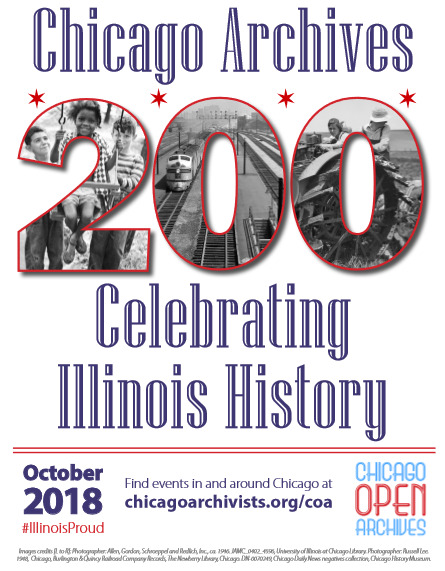
The physical exhibit of reproductions will be on display at the University of Chicago's Joseph Regenstein Library throughout the month of October, with some original materials on display in the Special Collections Research Center. For those of you who cannot visit in person, scroll down for a virtual view of our selections for this exhibit.
Transition from Territory to Statehood in Illinois
The oldest item displayed is a 1778 letter that was written when Illinois was a part of the American Revolutionary War's western theater. The letter, signed by George Wythe, George Mason, and Thomas Jefferson, congratulates George Rogers Clark on his appointment as the leader of a military expedition to the Northwest Territory. This was the beginning of a secret mission during the war later known as the Illinois Campaign, or Clark's Northwestern Campaign. Clark was ordered to seize control of Kaskaskia, Vincennes, and several other villages in French and British-held "Illinois Country." In the letter, the Virginia General Assembly mentions Native American raids in the territory which were instigated by the British. They also assure Clark that he and his soldiers will receive bounties of land as compensation. The nearby hand-drawn plat map demarcates the tract of 150,000 acres granted to Clark's soldiers in 1784.


Transcription of letter:
To George Rogers Clark Williamsburg Janry 3, 1776
Sir,
As some Indian Tribes to the westward of / the Missisippi have lately, without any provo- /cation massacred many of the Inhabitants upon / the Frontiers of this Commonwealth, in the / most cruel & barbarous manner, & it is intended / to revenge this injury & punish the Aggressors / by carrying the war into their own country. / We congratulate you upon your appoint / ment to conduct so important an Enterprize / in which we most heartily wish you / Success, and we have no Doubt that some / further reward in Lands in that country / will be given to the Volunteers who shall / engage in this Service, in addition to the / usual pay. If they are so fortunate to / Succeed, We think it just & reasonable that / each Volunteer entering[?] as a common Soldier in this Expedition, should be allowed three / hundred acres of Land, & the Officers in the / usual proportion, out of the Lands which may be conquered in the country now in / the possession of the said Indians; so as / not to interfere with the claims of any / friendly Indians, or of any people willing / to become Subjects of this Commonwealth, / and for this we think you may safely / confide in the justice & generosity of the / Virginia Assembly.
We are Sir Yr Most Hble. Servts
G. Wythe G. Mason Th. Jefferson
Letter from Virginia General Assembly to George Rogers Clark, January 3, 1778. Historical Manuscripts Collection, Box 24, Folder 15.
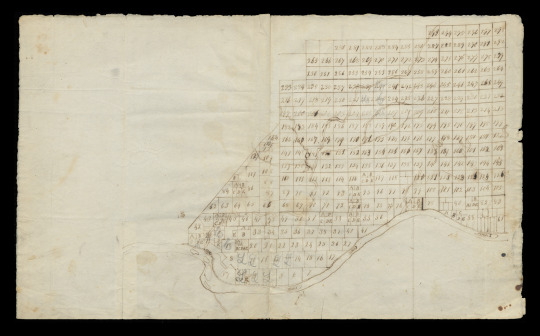
Plat of the Illinois Grant, 1784. Reuben T. Durrett Collection of Portraits, Illustrations, and Cartographic Material, Box 2, Folder 12.
Following the Revolutionary War, some, such as Gilbert Imlay, profited from the land grant system as surveyors. The 1797 edition of Imlay's popular A topographical description of the western territory of North America… served as an encyclopedia of North America for new settlers.
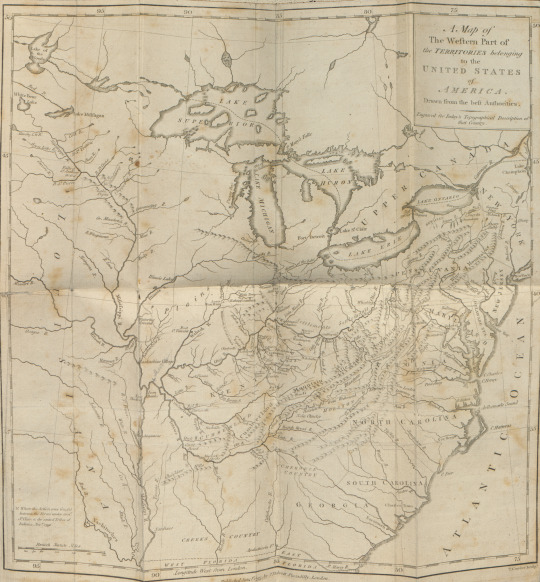
Imlay’s description of the Illinois country:
“The triangular tract of land at the head of this great vale, and between the Mississippi, the Ohio, and lake Erie (as that lake is vulgarly called), the country of the Illinois, is the finest spot of earth upon the globe, swelling with moderate hills, but no mountains, watered by the finest rivers, and of the most delightful climate; the soil, as appears from the woods with which it is clothed, is of the most abundant fruitfulness in vegetation. It abounds with coal; and there are multitudes of salt springs in all parts of it. There are mines of iron, copper, and lead. Wild rye grows here also spontaneously.” (p. 101)
Imlay’s Topographical description also reproduced the text of one Mr. Patrick Kennedy’s journal of an expedition in 1773 from Kaskaskia to the head of the Illinois river.

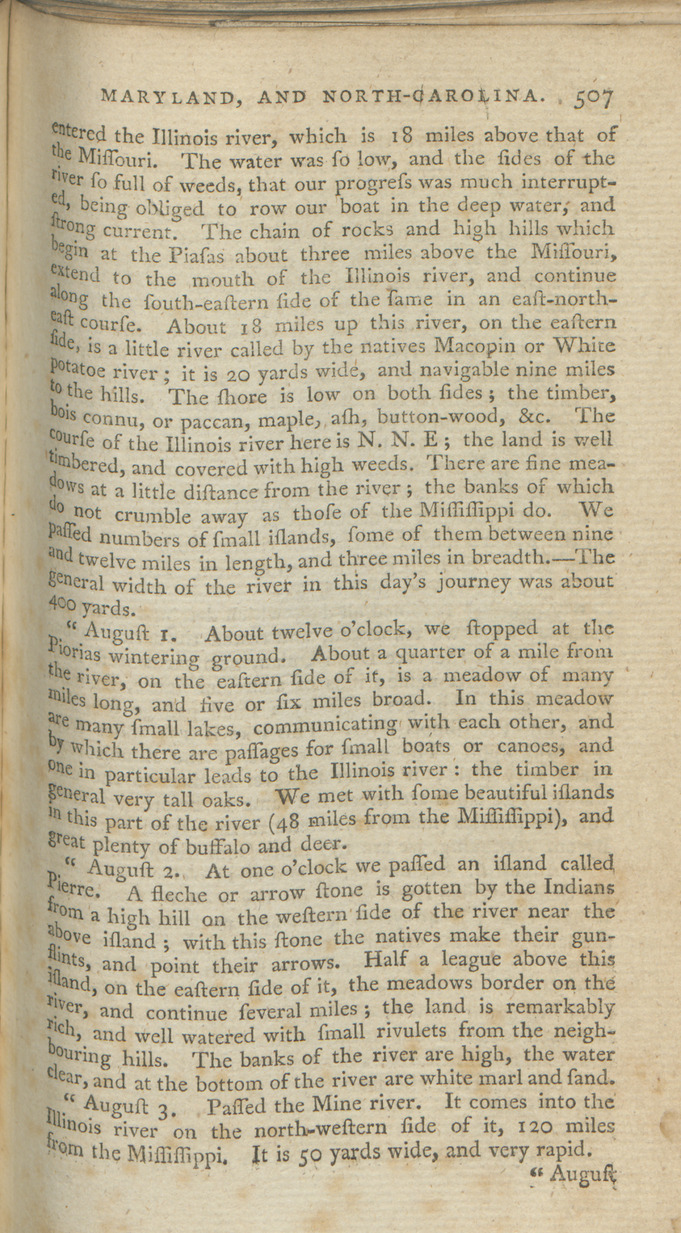
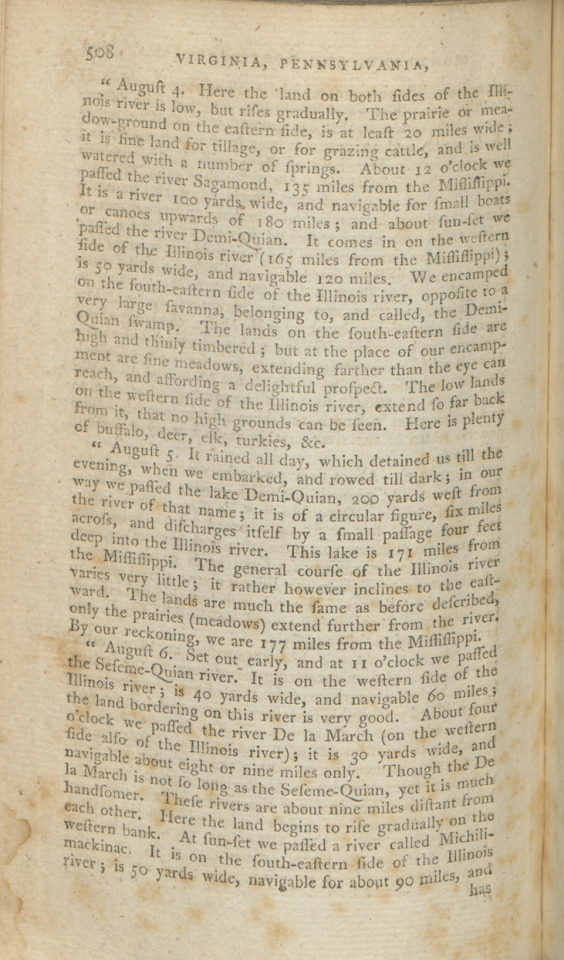

Imlay, Gilbert (1754?-1828?). A topographical description of the western territory of North America… London: Printed for J. Debrett, 1797. F352.I33 Rare c.1
The practice of granting Illinois land to volunteer soldiers continued in the War of 1812. American Nicholas Biddle van Zandt's 1818 Description of Military Lands describes three tracts of bounty lands, including the Illinois Military Tract which was situated between the Mississippi and Illinois rivers. The aim of Van Zandt’s text was to “give a faithful, a substantial, and, it is hoped, a satisfactory view of the Illinois and Missouri territories” and to aid settlers in selecting “the very spot upon which he may fix his habitation and his home.” Van Zandt also describes the Illinois Territory as a whole including an early description of the Chicago River and its potential as a “safe and commodious harbor for shipping” and the means by which the sand bank blocking the entrance to Lake Michigan might be removed.


Van Zandt, Nicholas Biddle. A full description of the soil, water, timber, and prairies of each lot, or quarter section of the Military Lands between the Mississippi and Illinois rivers. Washington City: Printed by P. Force, 1818. F547.M6 V28 1818 Rare c.1
Numerous accounts of the Illinois Territory were published, many with hopes of attracting emigrants. Irish author Thomas Ashe expounded upon the natural history of the area in Memoirs of mammoth, and various other extraordinary and stupendous bones…
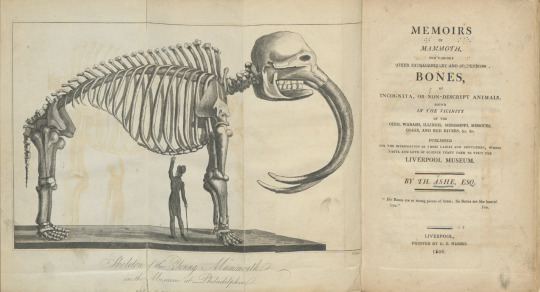
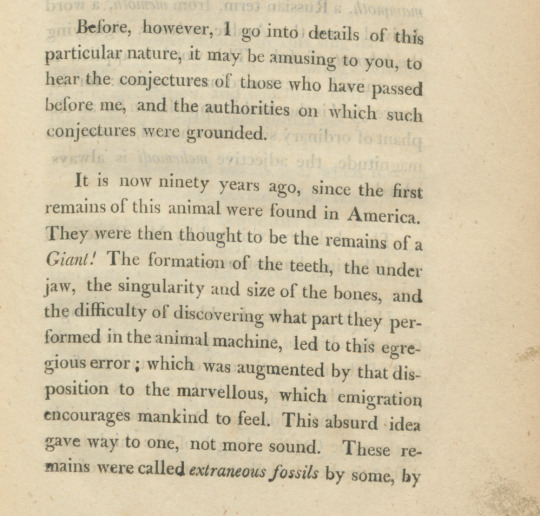
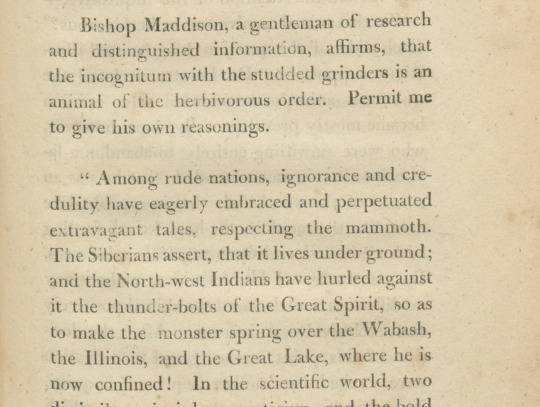
Ashe, Thomas (1770-1835). Memoirs of mammoth, and various other extraordinary and stupendous bones … found in the vicinity of the Ohio, Wabash, Illinois, Mississippi, Missouri, Osage, and Red Rivers. Liverpool: Printed by G. F. Harris, 1806. QE882.U7A8 Rare c.1
Adlard Welby’s A Visit to North America and the English Settlements in Illinois with a Winter Residence in Philadelphia included a description of the German settlement of Harmony, Illinois. Harmony was a settlement mostly comprised of poor Germans, though any person who agreed to live by the communal rules was allowed to join the community. The settlement lived by the principle of a communion of goods. That is, all of the harvested crops went into a communal store, and each person received the necessary amount of food. The tavern owner told author Adlard Welby: “We have every thing we can want, for our comfort and something more.”
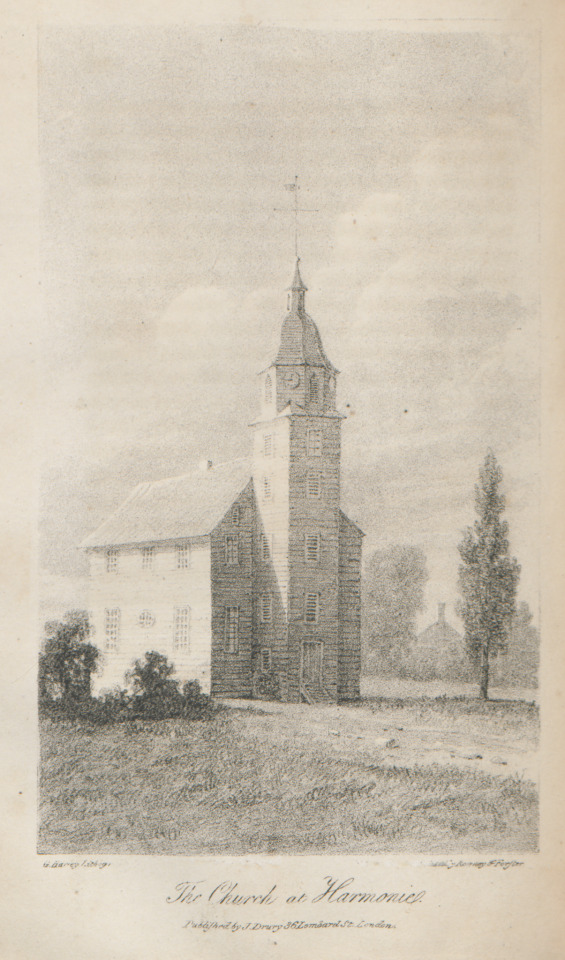
Welby, Adlard. A Visit to North America and the English Settlements in Illinois with a Winter Residence in Philadelphia. London: Printed for J. Drury, 1821. E41.W44 1821 Rare c.1
Morris Birkbeck, a British emigrant to the Illinois Territory who would later serve as Secretary of State of Illinois, described his American travel experiences and the establishment of the English Settlement, in Illinois Territory in Notes on a journey in America, from the coast of Virginia to the Territory of Illinois. First published in Philadelphia 1817, Notes, and its follow up, Letters from Illinois (1818), were wildly popular with multiple editions being published both in the United States and abroad, including multiple translations. The hand-colored map on display was published in the 1st London edition of Birkbeck’s Notes and includes all of the land traversed by Birkbeck’s party. Note the interesting placement of the borders of Indiana and the Illinois Territory; the location of Birkbeck’s settlement in the southeastern portion of the territory, on the Little Wabash River is captioned “The Prairie Settlement.”
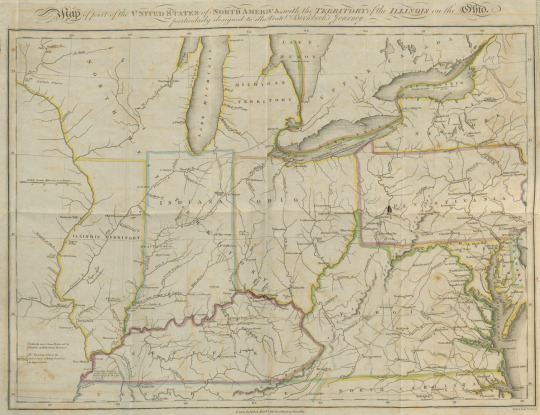

Birkbeck, Morris (1764-1825). Notes on a journey in America: from the coast of Virginia to the Territory of Illinois. London: Printed by Severn & Redington, for Ridgway and Sons, 1818. E162.B617 1818 Rare c.1
Birkbeck’s Letters from Illinois recounts his experiences living in the English Settlement and served to introduce Europeans (and hopefully convince them to emigrate) to the advantages of America.
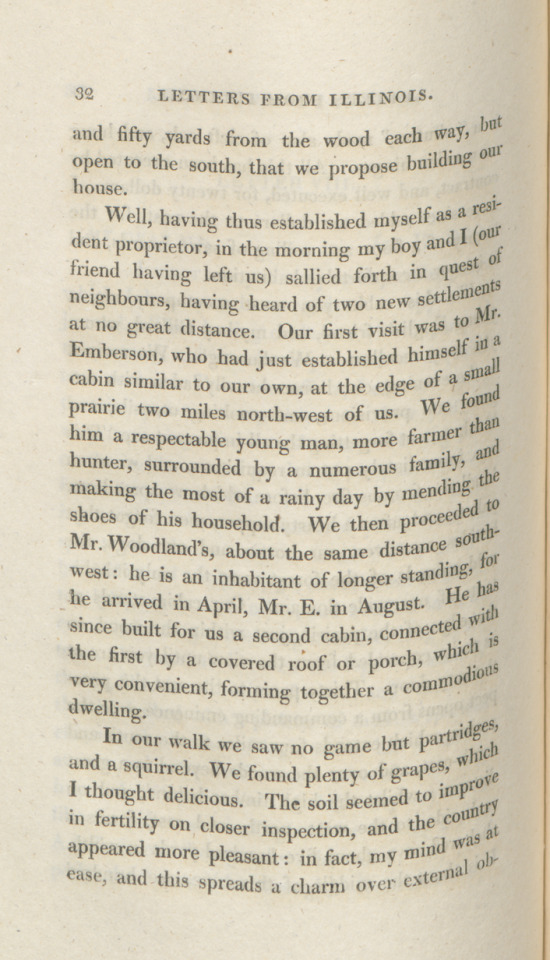

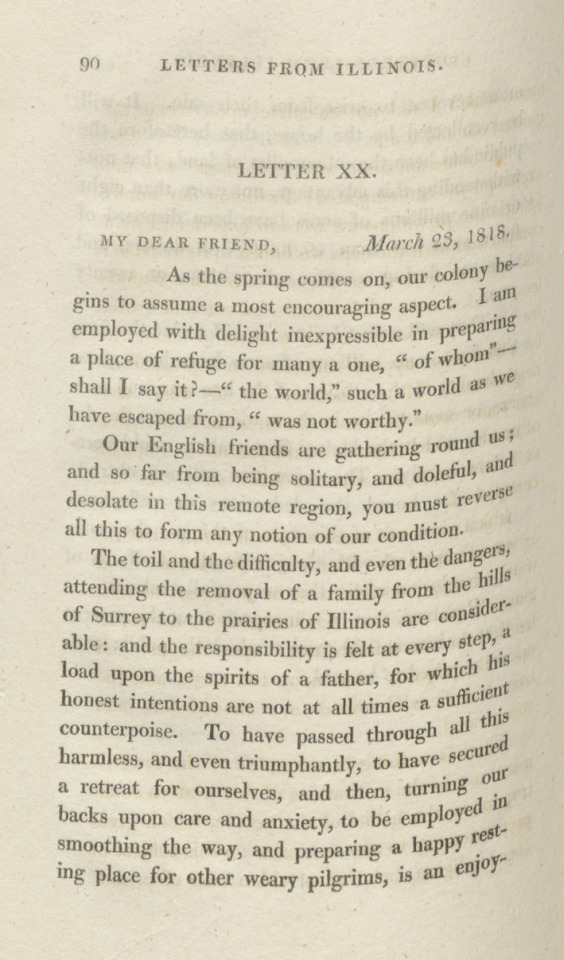
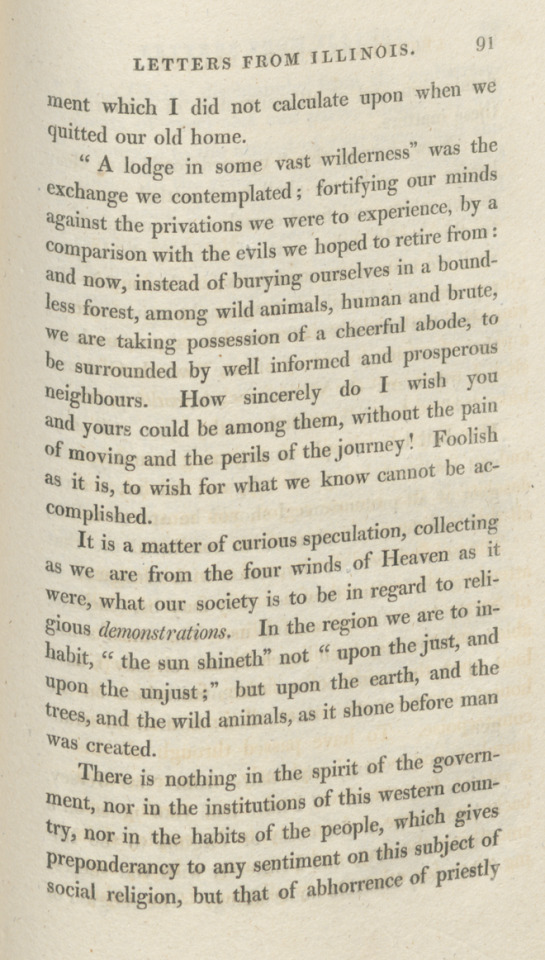
Birkbeck, Morris (1764-1825). Letters from Illinois. London: Printed for Taylor and Hessey, 1818. F545.B61 Rare c.1
British emigrant John Woods’ Two years’ residence describes his journey from England to the English Settlement in Illinois, along with the flora, fauna, agriculture, buildings, and business in the region. Woods' “Map of the allotments” shows the towns and ranges of the lower portion of Illinois.

Woods also provided a description of Birkbeck’s settlement, Wanborough:
“Mr. Birkbeck’s settlement, called Wanborough, is situated at the north-west corner of the English Prairie, and contains 25 cabins, a tavern, a store or two, and several lodging houses; and several carpenters, bricklayers, brick-makers, smiths, wheelwrights, and sawyers; also a taylor and butcher ... The building lots, at Wanborough, are some of five, and others of two and a half acres, laid out, like most of the American towns, in streets that cross each other at right angles, running north and south; the cross ones east and west. The lots are in the woods, but a considerable quantity of the wood is now cleared.” (p. 160-161)
Woods, John (-1829). Two years’ residence in the settlement on the English Prairie, in the Illinois country, United States: with an account of its animal and vegetable productions, agriculture, &c. &c., with the habits and customs of the back-woodsmen. London: Printed for Longman, Hurst, Rees, Orme, and Brown, 1822. F547.E2W9 1822 Rare c.2
As Illinois inched closer to statehood in 1817, Cook and Blackwell - the first printers in Illinois - published a list of laws, many to establish county seats and courthouses. (Cook County, Illinois is named for printer Daniel Cook).
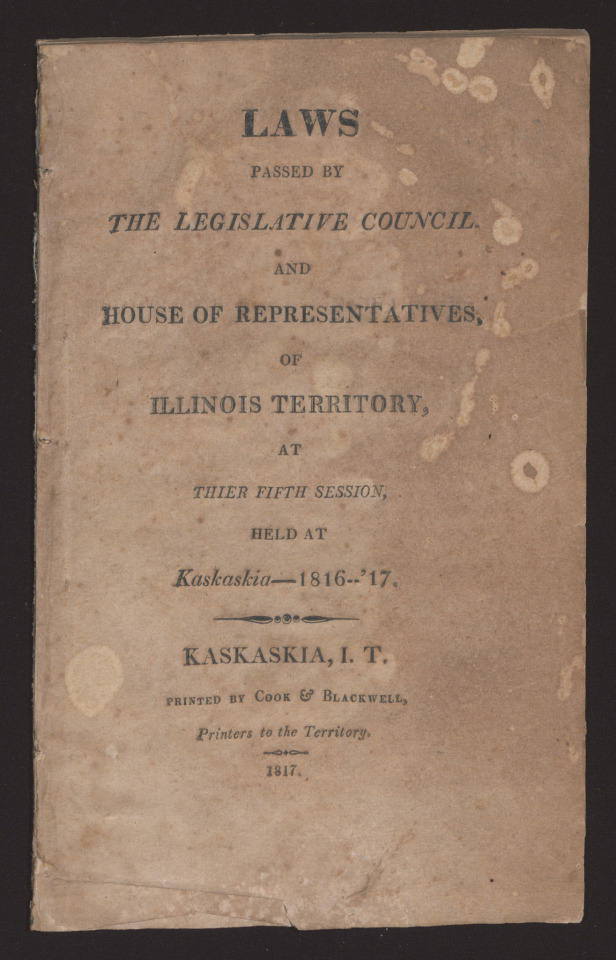
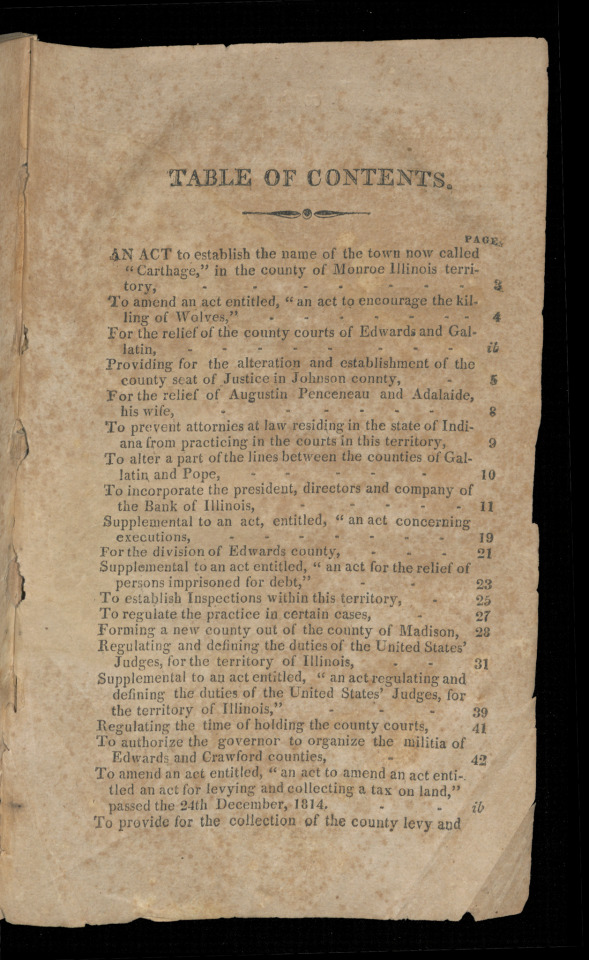
Laws passed by the Legislative council, and House of representatives, of Illinois territory, at their fifth session, held at Kaskaskia, 1816-'17. Kaskaskia, I.T.: Printed by Cook and Blackwell, printers to the territory, 1817. KFI1225.2 1816, Lincoln Collection
Counties and major cities in early Illinois were very different from what they are now. Kaskaskia was the capital of the Illinois Territory from 1809 to 1818. Located on the Mississippi River, it was flooded many times and the decision was made to move the capital to Vandalia in 1819, 70 miles northeast of St. Louis. Louis Beck's 1823 A gazetteer of the states of Illinois and Missouri… includes a plan for the new capital and the neighboring streets. It also describes Chicago as a small place of 10 or 15 homes in Pike County.


Beck, Lewis C. (1798-1853). A gazetteer of the states of Illinois and Missouri…Albany: Printed by C.R. and G. Webster, 1823. F539.B390 Rare c.1
#illinois#english settlement#illinois territory#statehood#chicago open archives#illinois country#early chicago#kaskaskia#vandalia
39 notes
·
View notes
Text
Books On Books Collection - Warja Lavater
Books On Books Collection – Warja Lavater
Warja Lavater’s work first came to this collection’s attention through Jeffrey Abt and Buzz Spector. Entitled Jeu: livre en “papier modulé” (1980), the work had been included in an exhibition organized by Abt and, for which, Spector designed the catalogue: The Book Made Art: A Selection of Contemporary Artists’ Books, exhibited in the Joseph Regenstein Library, The University of Chicago, February…

View On WordPress
#Adrien Maeght#Blaise Cendrars#Buzz Spector#Italo Calvino#Jeffrey Abt#Les Doights Qui Rêve#Marcelle Marquet#Myriam Colin#Shirley Sharoff#Sonia Delaunay#Souza Desnoyer#Warja Lavater#William Joyce
0 notes
Photo


[ youtube / zip ]
Last year’s pisces mix was about idolatry, relationships, and venus-neptune; this one is about space, time, and mercury-jupiter. There are 40 pisces across 40 songs. I imagine them played as two parts, as I’ve represented them here, or else atmosphere for an approximately two and a half hour event.
If you listen to or download this mix, I ask that you toss at least $5 (or whatever you can manage) (ideally more) toward Colonel Meowmers’ peehole surgery. Colonel’s mom is a Bradley Nowell 2/22 pisces, and she was one of my main inspirations for this mix. She’s almost met her target, and we’re hoping he’ll have a long and comfy life ahead of him after this procedure. S A V E H I M.
No spotify this time-- NO SPOTIFY TIL THEY GET NIANDRA LADES AND USUALLY JUST A T-SHIRT! --so I’m offering a download and youtube. Youtube playlists are wonky & all the versions are inferior! I tried to upload the Danny Brown song and it already got blocked for copyright. Just download it! Let me know if/when the download link fails. There’s mp3s and an m3u playlist file.
sides a & b: In the Someday
1. Nirvana - "I Hate Myself and Want to Die" 2. the Apples in Stereo - "Pine Away" 3. Solomon Grundy - "Out There" 4. Mudhoney - "If I Think" 5. Mary Lou Lord - "Some Jingle Jangle Morning" 6. Doc Corbin Dart - "Out My Window" 7. Kendra Smith - "Wheel of the Law" 8. Sublime - "Santeria" 9. Sly & the Family Stone - "Time" 10. Pink Floyd - "On the Run" 11. X - "Drunk in My Past" 12. Kesha Rose Sebert - "Old Flames Can't Hold a Candle to You" 13. Three Fish - "Song for a Dead Girl" 14. Public Enemy - "Cold Lampin' With Flavor" 15. Magazine - "Definitive Gaze" 16. John Frusciante - "Running Away into You" 17. Sugar Ray - "Falls Apart" 18. Throbbing Gristle - "Hot on the Heels of Love" 19. The Dream Syndicate - "Until Lately" 20. Townes Van Zandt - "At My Window"
sides c & d: One Foot in Heaven
21. The Fall - "To Nkroachment: Yarbles" 22. Alice in Chains - "Got Me Wrong" 23. Choking Victim - "Fucked Reality" 24. Lush - "Ocean" 25. The Who - "Anyway, Anyhow, Anywhere" 26. Adolescents - "Wrecking Crew" 27. Japan - "All Tomorrow's Parties" 28. Victoria Justice - "All I Want Is Everything" 29. Method Man - "Stimulation" 30. Green River - "This Town" 31. Suicidal Tendencies - "Possessed" 32. Danny Brown - "Dance in the Water" 33. Yes - "The Fish (Schindleria Praematurus)" 34. the Apples in Stereo - "Shine (In Your Mind)" 35. Coheed & Cambria - "Time Consumer" 36. The Highwaymen - "Death and Hell" 37. John Frusciante - "Untitled #6" 38. Thursday - "The Dotted Line" 39. Sublime - "Badfish" 40. Anti-Flag - "No Difference"
*in the youtube playlist I included the official video for the three fish song and it’s, wow, my goodness. I love this song though!
art:
Richard Hamilton (2/24/1922), “Soft Blue Landscape,” 1979 Walter Netsch (2/23/1920), Westinghouse Electric Research Development Center (and site), 1973 Frank Bowling (2/29/1936), “Mirror,” 1966 interior of Netsch’s Joseph Regenstein Library, 1970
32 notes
·
View notes
Link
If the University decides to bargain with SLEU, it could affect over 200 students—as of the election last year, there were 225 student library workers eligible to vote—spanning the entire University of Chicago Library system, including students employed at the Joseph Regenstein Library, the Joe and Rika Mansueto Library, Eckhart Library, John Crerar Library, D'Angelo Law Library, and the Social Services Administration Library.
Fourth-year SLEU representative Katie McPolin noted that the decision comes at an important moment for labor in higher education, on the heels of Grinnell University student worker union’s decision to unionize. “When admin are provided the opportunity to engage with student workers—both in GSU and in SLEU—they have chosen, over and over again, to silence student voices. We are excited for this movement forward on the path to a democratic university,” McPolin told The Maroon.
Undergraduate unionization, a nascent form of labor organizing, is coming under increased scrutiny nationally as student workers clash with administrations reluctant to bargain with a new class of employees.
#labor unions#labor exploitation#labor rights#university libraries#library workers#academic libraries#university of chicago#U Chicago
0 notes
Photo

Originally home to #UChicago’s Big Ten football program, Stagg Field was the site of the first nuclear chain reaction, which occurred in 1942 under its west stands. It was demolished in 1957, and the Joseph Regenstein Library was later built on the site. Extending from Regenstein is the Joe and Rika Mansueto Library, where UChicago students, researchers, and faculty continue to push the frontiers of science with the assistance of book-retrieving robots. #Nuclear75 http://ift.tt/2BmxeAX
0 notes
Photo

University of Chicago's Joseph Regenstein Library
0 notes
Text
Brutalist library in Chicago gets interior update by Woodhouse Tinucci
US firm Woodhouse Tinucci Architects has spruced up a reading room in the University of Chicago's Joseph Regenstein Library, a 1970s building originally designed by Skidmore, Owings & Merrill.
Totalling 18,000 square feet (1,672 square metres), the project entailed transforming a ground-level reading room of the brutalist library into a space more suitable for group meetings and study sessions. The space formerly was dominated by cubicles, filing cabinets and outdated study desks.
"The University of Chicago's Joseph Regenstein Library is one of the great academic libraries of the world, but it lacked an important component of today's most dynamic learning environments – a collaborative learning centre where students can work together in interactive groups," said Woodhouse Tinucci Architects.
The local firm has also worked on library renovations at Northwestern University and the University of Illinois at Chicago.
The Regenstein Library opened in 1970 and was named after industrialist and philanthropist Joseph Regenstein. It was designed by Walter Netsch, a partner at SOM known for iconic works such as the Cadet Chapel as the US Air Force Base in Colorado Springs.
The 577,085-square-foot (53,612-square-metre) facility contains over 4.5 million print volumes, making it one of the largest book repositories in the world, according to the university. Its distinctive exterior cladding is formed from scored limestone slabs.
Woodhouse Tinucci Architects sought to preserve the reading room's original character, including its thick concrete columns, while updating the space for modern use.
"[Our] innovative designs update Netsch's signature raw, functional style by creating vibrant, open learning areas better suited to today's more collaborative style of learning," the firm said.
The most significant move was creating an open, central area that is divided up by movable panels fitted with whiteboards, lighting and power connections.
A range of seating types are offered, including lounge chairs with low tables and stools lining a high bar.
Stretching along one side of the room is a mullion-free glass wall that is intended to "open the space to the sunken garden outside and pull its daylight deep inside".
Another wall is lined with square pods that serve as more private areas for group gatherings.
Future phases of the project call for a 36-seat digital classroom and an experimental area called The Egg.
While the Regenstein Library is still in active use, other brutalist buildings in Chicago have not fared so well. In 2013, the Prentice Women's Hospital, designed by Bertrand Goldberg & Associates, was demolished to make way for a new facility.
Related story
10 of Chicago's lesser-known architectural gems
The post Brutalist library in Chicago gets interior update by Woodhouse Tinucci appeared first on Dezeen.
from ifttt-furniture https://www.dezeen.com/2017/07/11/brutalist-joseph-regenstein-library-chicago-som-skidmore-owings-merrill-interior-design-update-renovation-woodhouse-tinucci/
1 note
·
View note
Photo

Skidmore, Owings & Merrill, Joseph Regenstein Library, Floor Plan, University of Chicago, Chicago, Illinois
#architecture#library#Skidmore Owings and Merrill#SOM#joseph regenstein library#university of chicago#chicago#plan#floor plan#layout
75 notes
·
View notes
Photo

Originally home to #UChicago’s Big Ten football program, Stagg Field was the site of the first nuclear chain reaction, which occurred in 1942 under its west stands. It was demolished in 1957, and the Joseph Regenstein Library was later built on the site. Extending from Regenstein is the Joe and Rika Mansueto Library, where UChicago students, researchers, and faculty continue to push the frontiers of science with the assistance of book-retrieving robots. #Nuclear75 http://ift.tt/2BmxeAX
0 notes
Photo

University of Chicago's Joseph Regenstein Library
0 notes
Photo

University of Chicago's Joseph Regenstein Library
0 notes
Photo

University of Chicago's Joseph Regenstein Library
0 notes
Photo

University of Chicago's Joseph Regenstein Library
0 notes
Photo

University of Chicago's Joseph Regenstein Library
0 notes